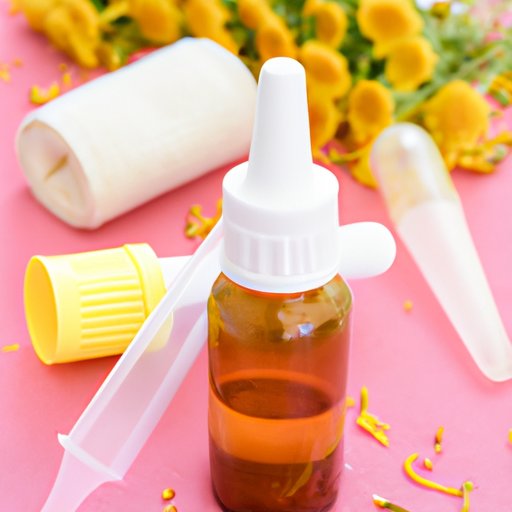
Introduction
Bee stings can be painful and potentially dangerous. They occur when a bee injects venom into your skin through its stinger. While bee stings are not always serious, some people may experience an allergic reaction that can be life-threatening. This article will explore natural remedies, over-the-counter medications, first aid techniques, prevention tips, and the importance of bees in our ecosystem to learn about how to deal with bee stings.
Natural Remedies for Dealing With Bee Stings
Several natural remedies can help alleviate bee sting symptoms, including:
Baking Soda
Mix baking soda with enough water to form a paste and apply it to the affected skin area. Baking soda is not only a natural acid neutralizer but can also provide immediate relief from itching and swelling caused by bee venom.
Vinegar
Applying vinegar to the affected area can help alleviate pain, itchiness, and swelling caused by bee venom. It has antibacterial and anti-inflammatory properties that can reduce the risk of infection and promote faster healing.
Essential Oils
Applying essential oils, such as lavender, tea tree, or peppermint oil, to the bee sting site can also help reduce inflammation and pain. These oils have natural anti-inflammatory, analgesic, and antiseptic properties that can help treat bee sting symptoms effectively.
Over-the-counter Medications That Can Provide Relief from Bee Sting Symptoms
Several over-the-counter medications can help alleviate bee sting symptoms, including:
Antihistamines
Oral antihistamines, such as diphenhydramine (Benadryl), can help reduce itching, swelling, and hives caused by bee venom effectively. They work by blocking the histamines that your body produces in response to an allergic reaction.
Painkillers
Nonsteroidal anti-inflammatory drugs (NSAIDs), such as ibuprofen (Advil) or acetaminophen (Tylenol), can help alleviate pain and reduce inflammation caused by bee stings.
Topical Creams
Over-the-counter topical creams containing hydrocortisone, lidocaine, or pramoxine can also help relieve itching, pain, and swelling associated with bee stings. They work by numbing the affected area, reducing inflammation and itching reactions.
Identifying Potential Allergies and Warning Signs of Anaphylaxis
Some individuals may develop an allergic reaction to bee venom, leading to anaphylaxis. Symptoms can range from mild to severe and can include:
- Hives or welts
- Swelling of the face, lips, or tongue
- Difficulty breathing or swallowing
- Vomiting and diarrhea
- Dizziness or fainting
- Rapid pulse or low blood pressure
If you experience any of these symptoms after a bee sting, seek medical attention immediately.
Proper First Aid Techniques for Treating a Bee Sting
Proper first aid techniques can help alleviate bee sting symptoms and prevent infection. These include:
Removing the Stinger
If a bee stinger is present, remove it immediately by gently scraping it off the skin with a flat object, such as a credit card. Avoid using tweezers, as it may squeeze more venom into the affected area and worsen symptoms.
Cleaning the Affected Area
Wash the affected area with soap and water to reduce the risk of infection. Applying an ice pack or cold compress can also help reduce inflammation and swelling.
Prevention Tips to Lower the Risk of Bee Stings
Several prevention tips can help lower the risk of bee stings, including:
Wear Protective Clothing
Wearing protective clothing, such as long sleeves, pants, and closed-toe shoes, can help prevent bee stings.
Avoid Certain Flower or Scent Patterns
Bees are attracted to flowers and scented products, such as perfumes or lotions. Avoiding these patterns can help lower the risk of bee stings.
The Importance of Bees in Our Ecosystem
Bees play a vital role in our ecosystem, pollinating crops and plants that produce food for humans and animals. Unfortunately, bee populations are declining due to habitat loss, pesticide use, and disease. It is essential to safely relocate hives or prevent swarms without harming the bees.
Conclusion
Knowing how to treat bee stings is crucial to minimizing their impact and preventing complications. Natural remedies, over-the-counter medications, and proper first aid techniques can help alleviate bee sting symptoms. Identifying potential allergies, knowing the warning signs of anaphylaxis, and seeking medical attention when necessary are essential in severe cases. Prevention tips, such as wearing protective clothing and avoiding certain flower or scent patterns, can help lower the risk of bee stings. Lastly, it is crucial to understand and protect the importance of bees in our ecosystem.





